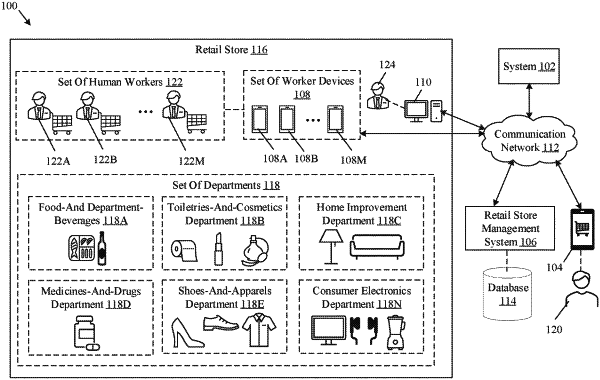| CPC G06Q 30/0633 (2013.01) [G06Q 10/02 (2013.01); G06Q 10/06312 (2013.01); G06Q 10/087 (2013.01)] | 19 Claims |

|
1. A system, comprising:
circuitry configured to:
receive a customer order for an in-store pickup at a retail store;
receive a set of inputs comprising:
slot-related information related to a first set of timeslots available at the retail store within a first time-period,
inventory information related to items sold by the retail store,
order preparation constraints related to a number of human workers at the retail store,
a history of customer orders associated with the retail store, and
initial weights for an objective function which include:
a first objective to maximize a service level for the received customer order above a service level threshold, wherein the service level for the received customer order is based on a customer preference for a first timeslot assigned to the received customer order and a time required to service the customer order in the first timeslot, and
a second objective to maximize a resource utilization of the number of the human workers within each of the first set of timeslots above a utilization threshold;
determine, based on the received set of inputs, a capacity constraint which sets a number of customer orders to be scheduled for the in-store pickup within each timeslot of the first set of timeslots;
divide the received customer order into a plurality of suborders based on the inventory information, wherein
each suborder of the plurality of suborders is associated with a department of a plurality of departments in the retail store, and
the order preparation constraints comprise an average time required by a human worker to service a specific sub-order, of a specific size, including at least one item associated with a specific department of the retail store;
train a first machine learning (ML) model and a second ML model on a training dataset for a slot prediction task, wherein the training dataset includes the history of customer orders of a first size;
select, at a first time, the first ML model for the slot prediction task based on the training dataset and an accuracy of each of the first ML model and the second ML model;
train the first ML model and the second ML model on an updated training dataset for the slot prediction task, wherein the updated training dataset includes the history of customer orders of a second size greater than the first size;
select, at a second time, the second ML model for the slot prediction task based on the updated training dataset and a change in the accuracy of each of the first ML model and the second ML model;
control one of the selected first ML model or the selected second ML model to determine, from the first set of timeslots, the first timeslot which accommodates the received customer order in accordance with the capacity constraint and the order preparation constraints, and for which a pickup wait time within the first timeslot is below a threshold; and
control a customer device to display the determined first timeslot.
|